Related Research Articles

The Celestines were a Roman Catholic monastic order, a branch of the Benedictines, founded in 1244. At the foundation of the new rule, they were called Hermits of St Damiano, or Moronites, and did not assume the appellation of Celestines until after the election of their founder, Peter of Morone, to the Papacy as Celestine V. They used the post-nominal initials O.S.B. Cel. The last house closed in 1785.
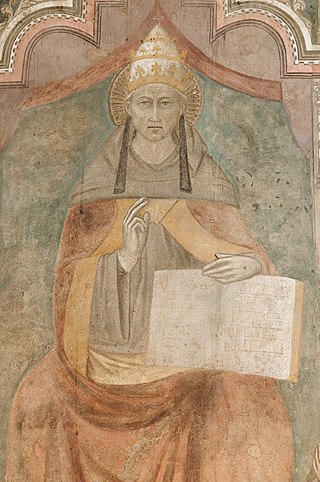
Pope Celestine V, born Pietro Angelerio, also known as Pietro da Morrone, Peter of Morrone, and Peter Celestine, was head of the Catholic Church and ruler of the Papal States for five months from 5 July to 13 December 1294, when he resigned. He was also a monk and hermit who founded the order of the Celestines as a branch of the Benedictine order.
The Fraticelli or Spiritual Franciscans opposed changes to the rule of Saint Francis of Assisi, especially with regard to poverty, and regarded the wealth of the Church as scandalous, and that of individual churchmen as invalidating their status. The Fraticelli were declared heretical in 1296 by Boniface VIII.
Angelo da Clareno, also known as Angelo Clareno, was the founder and leader of one of the groups of Fraticelli in the early 14th century.
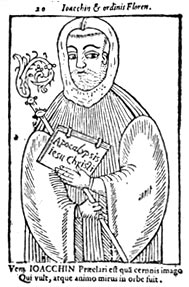
Joachim of Fiore, also known as Joachim of Flora and in Italian Gioacchino da Fiore, was an Italian Christian theologian, Catholic abbot, and the founder of the monastic order of San Giovanni in Fiore. According to theologian Bernard McGinn, "Joachim of Fiore is the most important apocalyptic thinker of the whole medieval period." The Divine Comedy of Dante Alighieri is one of the most famous works possibly inspired by his ideas.

San Francesco a Ripa is a church in Rome, Italy. It is dedicated to Francis of Assisi who once stayed at the adjacent convent. The term Ripa refers to the nearby riverbank of the Tiber.
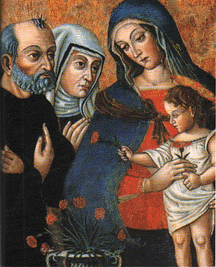
Simon of Cascia was an ascetic and preacher from Cascia, Italy. In his early days, he was influenced by the Spiritual Franciscan Angelo Clareno da Cingoli. He is commemorated on February 16.
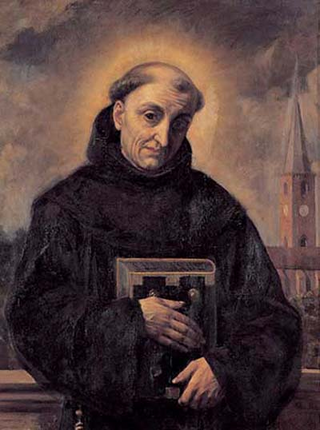
Angelo Carletti di Chivasso was a noted moral theologian of the Order of Friars Minor; born at Chivasso in Piedmont, in 1411; and died at Coni, in Piedmont, in 1495.

The Diocese of Macerata-Tolentino-Recanati-Cingoli-Treia is a Latin diocese of the Catholic Church in Italy. It is a suffragan of the Archdiocese of Fermo.

The Metropolitan Archdiocese of L'Aquila (Latin: Archidioecesis Aquilana is a Latin archdiocese of the Catholic Church in Italy. It was erected as the Diocese of Aquila on 20 February 1257 by Pope Alexander IV and promoted to an archdiocese by Pope Pius IX on 19 January 1876. Pope Paul VI elevated it to the rank of a metropolitan archdiocese on 15 August 1972, with the suffragan sees of Avezzano and Sulmona–Valva.

The Archdiocese of Chieti-Vasto is a Latin Church diocese of the Catholic Church which received that name in 1986, when the two separate dioceses, which had been governed by one and the same bishop, were united in one diocese. The diocese of Chieti had become the Archdiocese of Chieti in 1526, when promoted by Pope Clement VII. Chieti is about 8 miles (14 km) south-west of the Adriatic port city of Pescara.

The Custody of the Holy Land is a custodian priory of the Order of Friars Minor in Jerusalem, founded as the Province of the Holy Land in 1217 by Saint Francis of Assisi, who had also founded the Franciscan Order in 1209. In 1342, the Franciscans were declared by two papal bulls as the official custodians of the Holy Places in the name of the Catholic Church.
Pietro Peregrosso was a Roman Catholic legal scholar, ecclesiastical bureaucrat, and Cardinal (1288-1295). He had a sister, who was a nun at the convent of S. Agnete de Archagniago at the Porta Vercellina in Milan. He had a nephew, Belviso de Perego, to whom he left a legacy.

Angelo Tasca was an Italian politician, writer and historian. Born in Moretta, in the Piedmont region of Italy, he was a founding member of the Communist Party of Italy but was expelled in 1929 for his opposition to Stalinism and supporting the Right Opposition of Nikolai Bukharin. Having experienced persecution by the Fascist regime in Italy, he took refuge in France in 1926 and gained citizenship in 1936. After joining the French Section of the Workers' International in 1934, he worked as a writer for the newspaper Le Populaire.
Thomas of Tolentino was a medieval Franciscan missionary who was martyred with his three companions in Thane, India, for "blaspheming" Muhammad. His relics were removed to Quanzhou, China, and Tolentino, Italy, by Odoric of Pordenone. He is now venerated as a saint by the Roman Catholic Church, with his feast day on April 9.
Mark of Montelupone or Marco da Montelupone was a medieval Christian Franciscan missionary. He was among a group of included friars imprisoned for their extreme views.
Angelo of Tolentino was a 13th-century Franciscan missionary.
The Museo Civico di Mondavio is a public museum and art gallery (pinacoteca) located on Piazza Matteotti 3, where it is housed in the medieval former Franciscan monastery in the town center of Mondavio, in the Province of Pesaro e Urbino in the Italian region Marche.
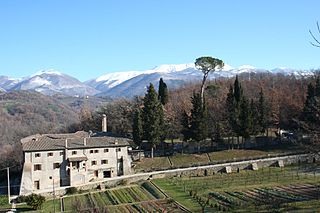
The Sanctuary of Santa Maria della Foresta, abbreviated as the Santuario della Foresta is one of a local cluster of four sanctuary-monasteries, originally based on rural oratories founded in the Rieti Valley by Francis of Assisi in the areas near Rieti, Lazio, Italy. This sanctuary is located about 3.5 km from Rieti, and near the town of Castelfranco.

Cesare Magati or Caesar Magatus was an Italian physician and professor of medicine. He is known chiefly from his book De rara medicatione Vulnerum (1616) where he promoted the idea of natural processes in wound healing. In 1618 he joined the Capuchin Order and the next year he took on the name of Padre Liberato da Scandiano.
References
- 1 2 La Rucola website, Le vicende di Angelo Clareno e di Pietro da Macerata, article by larucola, dated 18 June 2016
- 1 2 3 New Advent website, Celestines
- ↑ Treccani website, Angelo Clareno detto da Cingoli, beato
- ↑ Italia Medievale website, I Clareni e le Marche: alcuni esempi dal sud della regione, dated January 2, 2024
- ↑ New Advent website, Spirituals